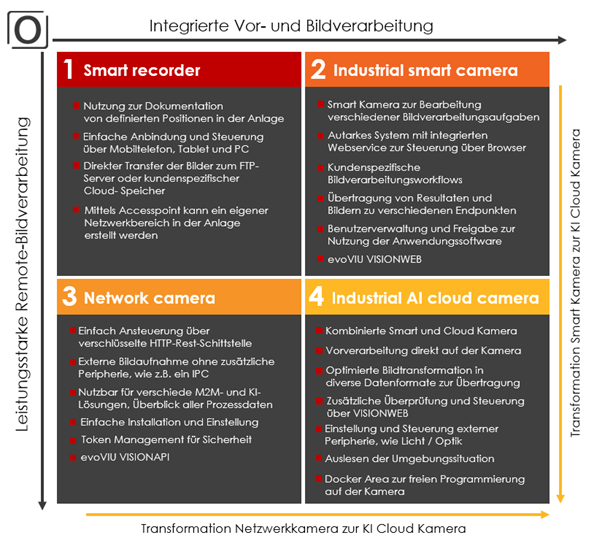Smart Kamera für Cloudanwendungen
Von Brückenlösungen bis hin zur cloudbasierten Smart Kamera
Smart Kameras haben sich mittlerweile als autarke Systeme bei verschiedenen Anwendungsfällen zur Bewertung von Produktionsteilen etabliert. Einen besonderen Vorteil bieten solche Kameras durch ihre kompakte leistungsstarke Bauweise in den Bereichen, in denen keine zusätzlichen Rechner oder deren Peripherie installiert werden kann. Nachteil ist, dass die Kameras meist nur für einen Anwendungsbereich ausgelegt sind und stetig durch den sich veränderten Produktionsablauf angepasst werden müssen. Deshalb entspricht die Lebenszeit von Smart Kameras in diesen Bereichen häufig nicht den Erwartungen der Nutzer. Es zeigt sich der Bedarf an anpassbaren, intelligenten Systemen, die trotz möglichen Änderungen und Erweiterungen in Produktionslinien erhalten bleiben und mit technischen Neuheiten mitwachsen können.
Brückentechnologie zum Cloud-Computing
Aus diesem Grund zeichnet sich der Lösungstrend ab, dass smarte Kamerasysteme immer mehr über KI-Anwendungen und Cloud-Computing angesteuert werden. Dabei vermischen sich die Vorteile beider Systeme. Zum einen bieten die Smart Kameras selbst eine umfangreiche Möglichkeit zur Vorverarbeitung von Bildern, wobei vor allem die skalierbare Performancestärke von externen Rechnereinheiten den ansteigenden Bedarf von schwierigen Überprüfungsmethoden optimiert lösen kann. Gleichzeitig ergibt sich dadurch die Möglichkeit, die Systeme in der Gesamtheit mit der Anlage besser zu synchronisieren. Viele Anwender sind aktuell auf der Suche nach einer Brückentechnologie, was bedeuten soll, dass sie ihre Aufgaben vorerst klassisch mit einer Smart Kamera lösen möchten, dennoch gewappnet für einen späteren Umstieg auf das Cloud Computing sein möchten. Im Idealfall soll dafür keine neue Hardware benötigt und die Kamera lediglich durch Software-Updates an die neue Umgebung angepasst werden. So kann wenig Geld für Peripherie und Infrastruktur ausgegeben und trotzdem ein langlebiges Konzept integriert werden.
evoVIU als cloudbasierte Smart Kamera
Die Smart Kamera evoVIU kann beiden Anforderungen gerecht werden, da sie sowohl als autarke Smart Kamera als auch als cloudbasierte Smart Kamera verwendet werden kann. Und zwar ohne notwendige Anpassungen an den bestehenden Hardware-Begebenheiten. Das bietet Anwendern offensichtliche Vorteile. Die evoVIU kann schnell integriert werden, da dafür nur eine Stromversorgung und eine Ethernet Leitung benötigt werden. Danach kann die Kamera direkt vor Ort und ohne Installation von zusätzlicher Software für individuelle Begebenheiten über alle Endgeräte eingestellt werden.
Bei Nutzung der Smart Kamera ohne cloudbasierte Lösungen, können Bildverarbeitungsaufgaben direkt auf der Kamera vorgenommen und an definierte Endpunkte gesendet werden. Soll die evoVIU Smart Kamera über die Cloud angesteuert werden, können Befehle zur Steuerung und Regelung der Bildaufnahme über eine verschlüsselte http-REST-Schnittstelle erbracht werden.

Workflow der evoVIU bei cloudbasierter Nutzung
Nach erfolgreicher Installation der evoVIU folgt die optimale Einstellung des gewünschten Bildes. Sind diese zwei Punkte erledigt, kann die bei diesem Prozess eindeutig erstellte UUID abgespeichert und an den KI-Programmierer übergeben werden. Dieser schreibt den Code zur Auswertung des aufgenommenen Teils, speichert das Bild ab und optimiert somit das Trainingsset. Bei Produktions- und Aufnahmestart wird die Image Source auf der evoVIU erstellt und aktiviert. Nach einem Trigger-Eingang wird das Bild aufgenommen und verarbeitet. Das verarbeitete Bild wird bewertet, als ok oder nicht ok eingestuft und als weitere Referenz und zur Optimierung des Trainings-Sets gespeichert.
Weitere Beiträge:

Release Update V5.5.0
Das Release Update V5.5.0 ist da! Es gibt viele Verbesserungen für das Dashboard und für den Workflow. Schaut gern rein!

Industrielle Bildverarbeitung: Ein Einblick in die moderne Technologie 2024
Industrielle Bildverarbeitung: Seit vielen Jahren beschäftigen wir uns intensiv mit der industriellen Bildverarbeitung, doch was verbirgt sich eigentlich hinter diesem oft verwendeten Begriff?

Endlich: Die neue VIU2 PoE Kamera ist da!
Die VIU2 PoE Kamera ist da! Warum PoE ein wichtiges Feature ist, erfahrt ihr in diesem Artikel.

Release Update V5.4.0
Das Release Update V5.4.0 ist da! Ein großen Dashboard Update, kleine Bugfixes und die Integration von persistenten Variablen sind darin enthalten.

5 reale Smart City Beispiele
Welche Smart City Beispiele gibt es eigentlich? Das erfahrt ihr in diesem Blog-Artikel.

Objekterkennung mit Bildverarbeitung
Objekterkennung ist für viele Industrien eine wichtige Möglichkeit um fehlerhafte Bauteile auszusortieren.

